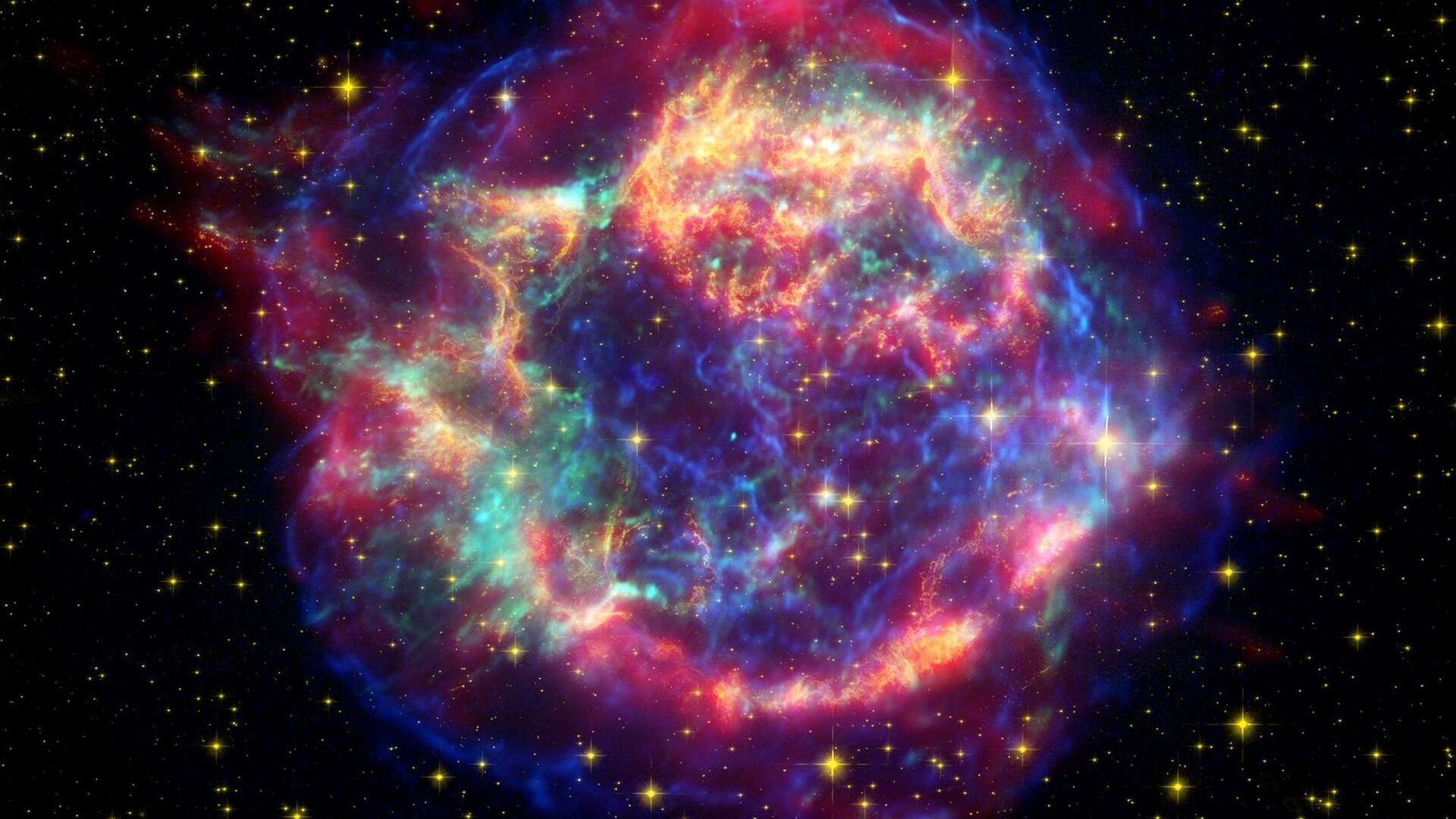https://sputnikglobe.com/20210917/cosmic-rerun-10-billion-year-old-supernova-will-soon-appear-again---scientists-reveal-why-1089147542.html
Cosmic Rerun? 10 Billion-Year-Old Supernova Will Soon Appear Again - Scientists Reveal Why
Cosmic Rerun? 10 Billion-Year-Old Supernova Will Soon Appear Again - Scientists Reveal Why
Sputnik International
According to astronomers, these reappearances may help them in finding more clues about the nature of dark matter, a mysterious substance that contributes to... 17.09.2021, Sputnik International
2021-09-17T08:31+0000
2021-09-17T08:31+0000
2023-04-21T10:42+0000
galaxy
universe
explosion
supernova
science & tech
https://cdn1.img.sputnikglobe.com/img/107295/07/1072950759_0:60:1920:1140_1920x0_80_0_0_b7cb77030f907863472f70221690a7a8.jpg
A supernova explosion that took place years ago will soon occur again. In 2016, the faint glint of an ancient 10-billion-year-old explosion appeared three times and was captured by NASA's Hubble Space Telescope. Now, scientists predict this same source of light will appear again in 2037. But why? A team of astronomers led by Steve Rodney, an assistant professor at the University of South Carolina in Columbia, explained in a study that the gargantuan cluster of galaxies that the supernova's light has to pass by on its way to Earth is the reason behind this cosmic rerun. The study came out in the journal Nature recently. This phenomenon called gravitational lensing occurs when an object with a massive gravitational force covers the light of distant stars and galaxies behind it. Sometimes, this leads to the magnification or distortion of the light of distant objects. According to the researchers, in the case of this supernova explosion, the galaxy cluster MACS J0138 is working as a brightening agent for the light and later multiplies and splits into different images at different points in time. The researchers in their study observed the ancient explosion also known as Supernova Requiem using computer models. Then, they calculated and predicted the pathways this light will go through on its way to Earth. They also studied dark matter's influence on the light. The scientists will be able to measure the precise time difference between all of the supernova images after it reappears. There is also a possibility of the reappearance of the flash for a fifth time in 2042, according to the scientists.
Sputnik International
feedback@sputniknews.com
+74956456601
MIA „Rossiya Segodnya“
2021
Sushmita Panda
https://cdn1.img.sputnikglobe.com/img/07e5/05/12/1082926186_0:0:2048:2048_100x100_80_0_0_4474d0d7e27a36878eb8727832be74b4.jpg
Sushmita Panda
https://cdn1.img.sputnikglobe.com/img/07e5/05/12/1082926186_0:0:2048:2048_100x100_80_0_0_4474d0d7e27a36878eb8727832be74b4.jpg
News
en_EN
Sputnik International
feedback@sputniknews.com
+74956456601
MIA „Rossiya Segodnya“
Sputnik International
feedback@sputniknews.com
+74956456601
MIA „Rossiya Segodnya“
Sushmita Panda
https://cdn1.img.sputnikglobe.com/img/07e5/05/12/1082926186_0:0:2048:2048_100x100_80_0_0_4474d0d7e27a36878eb8727832be74b4.jpg
galaxy, universe, explosion, supernova, science & tech
galaxy, universe, explosion, supernova, science & tech
Cosmic Rerun? 10 Billion-Year-Old Supernova Will Soon Appear Again - Scientists Reveal Why
08:31 GMT 17.09.2021 (Updated: 10:42 GMT 21.04.2023) According to astronomers, these reappearances may help them in finding more clues about the nature of dark matter, a mysterious substance that contributes to the majority of the universe's composition and binds galaxies together.
A supernova explosion that took place years ago will soon occur again. In 2016, the faint glint of an ancient 10-billion-year-old explosion appeared three times and was captured by NASA's Hubble Space Telescope. Now, scientists predict this same source of light will appear again in 2037. But why?
A team of astronomers led by Steve Rodney, an assistant professor at the University of South Carolina in Columbia, explained in a study that the gargantuan cluster of galaxies that the supernova's light has to pass by on its way to Earth is the reason behind this cosmic rerun. The study came out in the journal
Nature recently.
"Whenever some light passes near a very massive object, like a galaxy or galaxy cluster, the warping of space-time that Einstein's theory of general relativity tells us is present for any mass, delays the travel of light around that mass", Rodney said.
This phenomenon called gravitational lensing occurs when an object with a massive gravitational force covers the light of distant stars and galaxies behind it. Sometimes, this leads to the magnification or distortion of the light of distant objects.
According to the researchers, in the case of this supernova explosion, the galaxy cluster MACS J0138 is working as a brightening agent for the light and later multiplies and splits into different images at different points in time.
The researchers in their study observed the ancient explosion also known as Supernova Requiem using computer models. Then, they calculated and predicted the pathways this light will go through on its way to Earth. They also studied dark matter's influence on the light.
The scientists will be able to measure the precise time difference between all of the supernova images after it reappears. There is also a possibility of the reappearance of the flash for a fifth time in 2042, according to the scientists.


